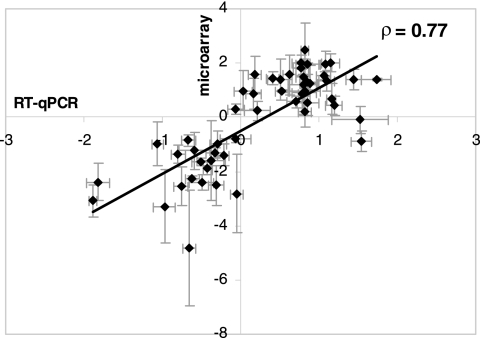The iron stimulon of Xylella fastidiosa includes genes for type IV pilus and colicin V-like bacteriocins.
Xylella fastidiosa is the etiologic agent of a wide range of plant diseases, including citrus variegated chlorosis (CVC), a major threat to citrus industry. The genomes of several strains of this phytopathogen were completely sequenced, enabling large-scale functional studies. DNA microarrays representing 2,608 (91.6%) coding sequences (CDS) of X. fastidiosa CVC strain 9a5c were used to investigate transcript levels during growth with different iron availabilities. When treated with the iron chelator 2,2'-dipyridyl, 193 CDS were considered up-regulated and 216 were considered down-regulated. Upon incubation with 100 microM ferric pyrophosphate, 218 and 256 CDS were considered up- and down-regulated, respectively. Differential expression for a subset of 44 CDS was further evaluated by reverse transcription-quantitative PCR. Several CDS involved with regulatory functions, pathogenicity, and cell structure were modulated under both conditions assayed, suggesting that major changes in cell architecture and metabolism occur when X. fastidiosa cells are exposed to extreme variations in iron concentration. Interestingly, the modulated CDS include those related to colicin V-like bacteriocin synthesis and secretion and to functions of pili/fimbriae. We also investigated the contribution of the ferric uptake regulator Fur to the iron stimulon of X. fastidiosa. The promoter regions of the strain 9a5c genome were screened for putative Fur boxes, and candidates were analyzed by electrophoretic mobility shift assays. Taken together, our data support the hypothesis that Fur is not solely responsible for the modulation of the iron stimulon of X. fastidiosa, and they present novel evidence for iron regulation of pathogenicity determinants.
Authors
Paulo A Zaini; Andréa C Fogaça; Fernanda G N Lupo; Helder I Nakaya; Ricardo Z N Vêncio; Aline M da Silva
External link
Publication Year
Publication Journal
Associeted Project
Life Sciences
Lista de serviços
-
StructRNAfinder: an automated pipeline and web server for RNA families prediction.StructRNAfinder: an automated pipeline and web server for RNA families prediction.
-
CEMiTool: a Bioconductor package for performing comprehensive modular co-expression analyses.CEMiTool: a Bioconductor package for performing comprehensive modular co-expression analyses.
-
webCEMiTool: Co-expression Modular Analysis Made Easy.webCEMiTool: Co-expression Modular Analysis Made Easy.
-
Assessing the Impact of Sample Heterogeneity on Transcriptome Analysis of Human Diseases Using MDP Webtool.Assessing the Impact of Sample Heterogeneity on Transcriptome Analysis of Human Diseases Using MDP Webtool.
-
Predicting RNA Families in Nucleotide Sequences Using StructRNAfinder.Predicting RNA Families in Nucleotide Sequences Using StructRNAfinder.
-
OUTBREAK: a user-friendly georeferencing online tool for disease surveillance.OUTBREAK: a user-friendly georeferencing online tool for disease surveillance.
-
Noninvasive prenatal paternity determination using microhaplotypes: a pilot study.Noninvasive prenatal paternity determination using microhaplotypes: a pilot study.
-
Editorial: User-Friendly Tools Applied to Genetics or Systems Biology.Editorial: User-Friendly Tools Applied to Genetics or Systems Biology.
-
Automatic detection of the parasite Trypanosoma cruzi in blood smears using a machine learning approach applied to mobile phone imagesAutomatic detection of the parasite Trypanosoma cruzi in blood smears using a machine learning approach applied to mobile phone images
-
Tucuxi-BLAST: Enabling fast and accurate record linkage of large-scale health-related administrative databases through a DNA-encoded approachTucuxi-BLAST: Enabling fast and accurate record linkage of large-scale health-related administrative databases through a DNA-encoded approach
-
Ten quick tips for harnessing the power of ChatGPT in computational biologyTen quick tips for harnessing the power of ChatGPT in computational biology

